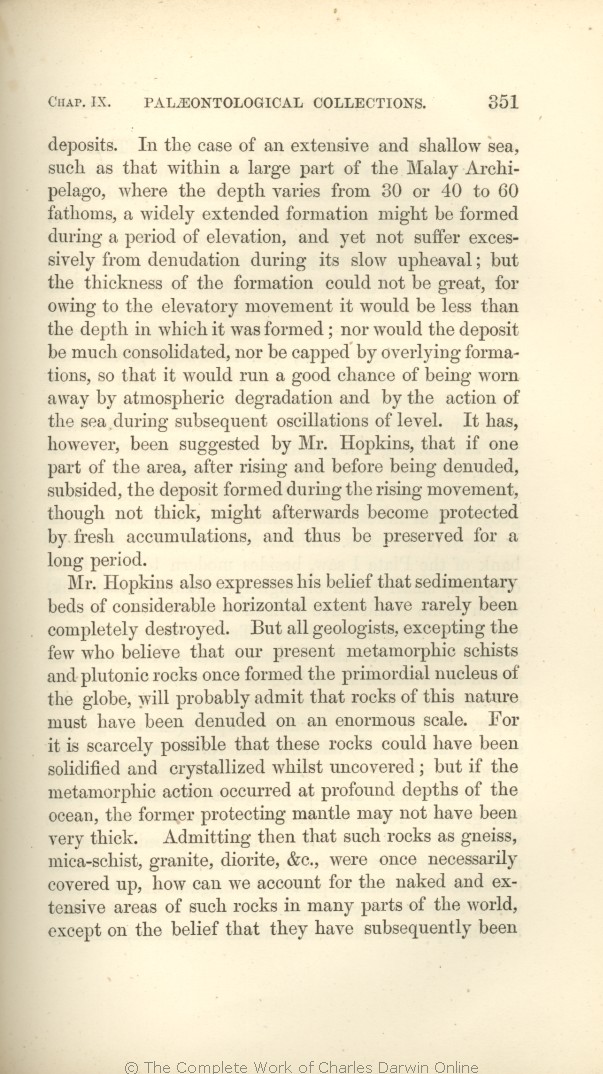deposits. In the case of an extensive and shallow sea, such as that within a large part of the Malay Archipelago, where the depth varies from 30 or 40 to 60 fathoms, a widely extended formation might be formed during a period of
elevation, | elevation, 1866 1869 1872 | | elevation 1861 |
| depth 1866 1869 1872 | | depth, 1861 |
| in which it was formed; nor would 1866 1869 1872 |
| supposed to be shallow; 1861 |
| OMIT 1866 1869 1872 |
| would not generally 1861 |
| ..... 1866 1869 1872 | | would it 1861 |
| overlying 1861 1866 1872 | | over- lying 1869 |
| by atmospheric degradation and by the action of the sea during 1866 1869 1872 |
| during 1861 |
| has, 1866 1869 1872 | | has 1861 |
| however, been 1866 1869 1872 | | been 1861 |
| afterwards become 1866 1869 1872 | | become 1861 |
| a long period. 1866 1869 1872 |
| an extremely long period,— a consideration which I formerly overlooked. 1861 |
|
|
Mr.
Hopkins | Hopkins 1866 1869 1872 | | Hopkins, 1861 |
| also expresses his belief that 1866 1869 1872 |
| in commenting on this subject, states that he believes the entire destruction of any 1861 |
| beds 1866 1869 1872 | | bed 1861 |
| ..... 1866 1869 1872 | | to 1861 |
| rarely been completely destroyed. 1866 1869 1872 |
| been of rare occurrence. 1861 |
| probably 1866 | probably 1869 1872 |
| rocks of this nature must 1866 |
| these latter rocks 1869 1872 |
| denuded on 1866 1869 |
| stript of their covering to 1872 |
| scale. 1866 1869 | | extent. 1872 |
| 4 blocks not present in 1859 1860 1866 1869 1872; present in 1861 | | My remarks apply solely to beds rich in fossils: I have admitted that sediment accumulated in extremely thick, solid, or extensive masses would escape denudation.
The point in question is, whether widely extended formations, rich in fossils, and of sufficient thickness to last for a long period, would be formed except during periods of subsidence?
My impression is that this has rarely been the case.
As the subject of complete denudation has been broached by Mr. Hopkins, I may remark that all geologists, excepting the few who believe that they see in the metamorphic schists and plutonic rocks the heated primordial nucleus of the globe, will probably admit that rocks of this nature must have been largely denuded.
|
| these 1861 1866 | | such 1869 1872 |
| could 1866 1869 1872 | | should 1861 |
| whilst uncovered; 1866 1869 1872 |
| in a naked condition; 1861 |
| protecting mantle 1866 |
| mantle 1861 |
| protecting mantle of rock 1869 1872 |
| very thick. 1866 1869 1872 | | thick. 1861 |
| such rocks as 1861 1866 |
| OMIT 1869 1872 |
| &c., 1866 1869 1872 | | &c, 1861 |
| naked 1866 1869 1872 | | extensive 1861 |
| extensive 1866 1869 1872 | | naked 1861 |
|









